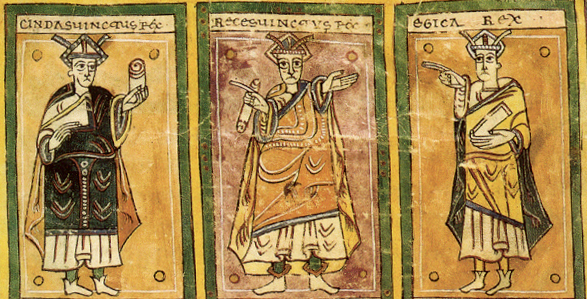VISIGOTHIC CHURCH COLLECTION
The history of the Church in Visigothic Spain spans a period of significant transformation, from the establishment of Christianity among the Visigothic rulers to the eventual emergence of medieval Spain. This history reflects the interplay between religious and political power, as well as the evolution of ecclesiastical structure and theology during the Dark Ages and early Medieval period. The Visigothic Kingdom, which ruled large parts of the Iberian Peninsula from the 5th to the 8th centuries, played a crucial role in shaping the religious and cultural identity of Spain. The Visigoths were originally a pagan Germanic tribe that migrated through the Roman Empire and eventually settled in Hispania (modern-day Spain) in the early 5th century. In the early years of their rule, the Visigoths maintained their Arian Christian beliefs, which were distinct from the Nicene orthodoxy upheld by the Catholic Church. Arianism, which viewed Jesus Christ as subordinate to God the Father, was considered heretical by mainstream Christianity. The turning point in the religious history of Visigothic Spain came with King Reccared I in 589. Reccared, after converting to Catholicism, publicly renounced Arianism and embraced Nicene Christianity. This conversion not only solidified the Catholic faith as the official religion of the Visigothic Kingdom but also helped to align the Visigoths with the broader Christian community of the Roman world. At the Third Council of Toledo in 589, which was a significant ecclesiastical gathering, Reccared’s conversion was formally ratified. This event marked the beginning of the full Christianization of the Visigothic elite, and it had a profound impact on the religious landscape of Spain, creating a unified Catholic identity.
Following Reccared’s conversion, the Visigothic kings worked closely with the Church to consolidate both their political power and religious authority. The Church became an important ally of the monarchy, which sought to integrate the religious and political spheres in the governance of the kingdom. Toledo, the capital of the Visigothic Kingdom, became a central hub for ecclesiastical matters, and the Councils of Toledo played a key role in shaping Church law, defining heresy, and addressing disputes within the kingdom. The Councils of Toledo were a series of ecclesiastical assemblies held from the 5th to the 7th centuries, which sought to strengthen the relationship between the monarchy and the Church. These councils addressed a variety of theological, political, and social issues, including the regulation of clerical conduct, the relationship between church and state, and the enforcement of orthodoxy. The councils also helped to maintain the unity of the Christian faith in Spain and fostered a distinctly Hispano-Roman Christian culture. During the reign of King Sisebut (612–621), the Visigothic Kingdom actively worked to eliminate Jewish influence from society. Sisebut decreed that Jews be forcibly baptized, signaling a growing trend of Christian intolerance towards Jews. This policy culminated in the forced conversion or expulsion of Jews in the 7th century, reflecting the Church's role in shaping social policies of the time. As the 7th century came to a close, the Visigothic Kingdom began to experience internal strife and external pressures that weakened its unity. Political instability, succession struggles, and invasions by rival kingdoms contributed to the decline of the Visigothic monarchy. By the early 8th century, the kingdom was in a state of disarray. This period of weakness in Visigothic Spain coincided with the Islamic expansion into the Iberian Peninsula. In 711, the Muslim Umayyad forces defeated the Visigothic army at the Battle of Guadalete, leading to the rapid collapse of the Visigothic Kingdom. The majority of the Iberian Peninsula fell under Muslim rule, marking the end of the Visigothic period in Spain. Despite the fall of the Visigothic Kingdom, the legacy of the Visigothic Church endured. Toledo remained an important ecclesiastical center, and many of the clergy retreated to the mountainous regions in the north of Spain, where the Christian Reconquista began. In the early stages of the Reconquista, the Church played a central role in preserving the Christian faith and providing spiritual leadership to the Christian kingdoms that would later emerge, such as Asturias.
Although the Visigothic kingdom had fallen to the Muslims, the religious and cultural legacy of the Visigothic Church continued to influence the Christian kingdoms of medieval Spain. In the northern territories of the Iberian Peninsula, such as Asturias and Leon, the Christian faith was preserved and eventually became the foundation for the Christian kingdoms that would engage in the Reconquista — the centuries-long effort to reclaim Spain from Muslim rule. During this period, the Church of Spain remained a symbol of unity and religious continuity. It also served as a source of legitimacy for the rulers of these Christian kingdoms, who often sought the Church’s blessing and support in their military campaigns against Muslim forces. Charlemagne, through his Frankish influence, also played a role in the religious consolidation of the Christian north. The Pope provided moral support to the Christian kingdoms, and the papacy played a significant role in encouraging the Reconquista. The history of the Church in Visigothic Spain is marked by the transformation from Arianism to Catholicism, the consolidation of Christian authority through the Councils of Toledo, and the eventual fall of the Visigothic Kingdom to the Islamic forces. Despite the collapse of the Visigothic state in the 8th century, the Church’s influence endured, particularly in the northern Christian kingdoms that began the Reconquista. The Visigothic Church's legacy laid the foundation for the religious and cultural landscape of medieval Spain, which would later emerge as a united Catholic kingdom in the following centuries. The Church played an essential role in shaping the identity, governance, and social structure of Spain, making it a key force in the history of the Iberian Peninsula during the Dark Ages and early Medieval period.

